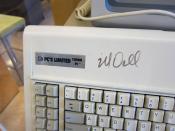Overview.
It started 21 years ago, when he was ditching classes to sell homemade PCs out of his University of Texas dorm room. Michael Dell was the scrappy underdog, fighting for his company's life against the likes of IBM and Compaq Computer Corp. with a direct-sales model that people thought was plain nuts. Now, Michael Dell is worth $17 billion, while his 40,000-employee company is about to top $40 billion in sales. Yet he continues to manage Dell with the urgency and determination of a college kid with his back to the wall. "I still think of us as a challenger," he says. "I still think of us attacking."
http://www.businessweek.com/magazine/content/03_44/b3856001_mz001.htm
Dell was founded in 1984 by Michael Dell. Dell started with a simple vision statement that by selling computer systems directly to customers, Dell could best understand their needs and efficiently provide the most effective computing solutions to meet those needs (Dell Official Website).
By selling directly to customers, Dell will also eliminate the time and costs that retailers add when selling their products. This direct model then offers customers the latest technology quicker than companies with slow moving and indirect distribution channels. With this vision in mind and his persistent focus on delivering the best possible customer experience by directly selling computing products and services, Dell has become one of the world's leading computer manufacturers. It has excelled in market leadership and re-defined and transformed the way marketing is and should be applied in our society. Its success is built on a foundation of personal and professional integrity.
Corporate Plan.
Through its direct business model, Dell designs, develops, manufactures, markets, sells, and supports a wide range of computer systems and services that are customized to customer requirements. These include enterprise systems (servers, storage and networking products, and workstations), client...


